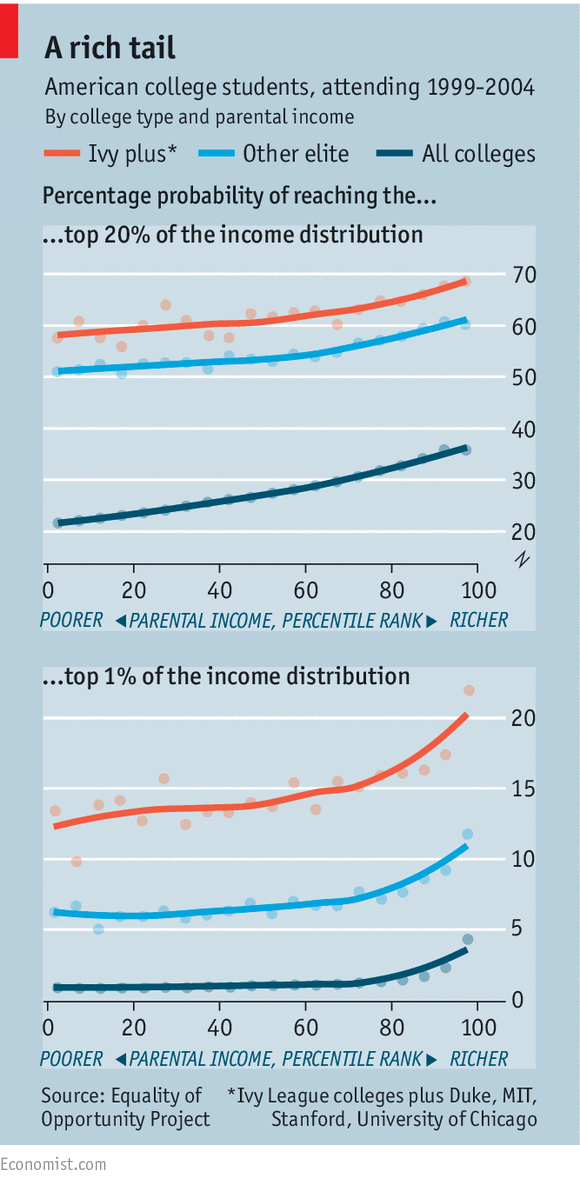New data show that joining the 1% remains unsettlingly hereditary

New data on American universities and their role in economic mobility—culled from 30m tax returns—published by Raj Chetty, an economist at Stanford University, and colleagues show that some colleges do a better job of boosting poor students up the income ladder than others. Previously, the best data available showed only average earnings by college. For the first time, the entire earnings distribution of a college’s graduates—and how that relates to parental income—is now known.
These data show that graduates of elite universities with single-digit admissions rates and billion-dollar endowments are still the most likely to join the top 1% (though having wealthy parents improves the odds). And despite recent efforts to change, their student bodies are still overwhelmingly wealthy.
Princeton University is the best at producing plutocrats—23% of its graduates end up as one-percenters, about the same as the share of its students who hail from equally wealthy households. Following closely are the University of Pennsylvania, Harvard and Stanford where this rich-in, rich-out model works well.
No matter their family income, students at America’s most prestigious universities have a roughly equal chance of reaching the top 20% of the income distribution. Reaching the top 1% is a different story altogether. In this case, having a trust fund appears handy. Even if a student attends an elite university, the chances of eventually reaching the economic elite increase greatly with the wealth of parents (see chart). A rich student, hailing from a household in the top 5%, has about a 60% greater chance of reaching the income summit than a poor student, whose parents were in the bottom 5%, even if they both attended one of America’s most esteemed universities. Elite financial and consulting firms, which often recruit for highly paid positions exclusively at Ivy League-calibre schools and rely on networking, may bear some of the blame.
Breaking into the upper-middle class is a good bit easier, our analysis of Mr Chetty et al’s data shows. Three of the important factors in determining the average earnings of graduates are test scores, where the college is located and what subjects the alumni studied. Those who do not get into Yale should feel relieved that a clear path to the upper-middle still exists: study a technical subject like engineering or pharmacology, and move to a large city. Graduates from lesser-known colleges focusing on science, technology and maths like Kettering University and the Stevens Institute of Technology earn, on average, just as much as their Ivy League peers.
Such colleges however, host just a fraction of America’s undergraduates. To identify which colleges are the best “engines of upward mobility”, Mr Chetty and his collaborators rank universities on their ability to move large numbers of students from the poorest 20% of the income distribution to the top 20%. The best at this are mid-tier public universities like the City University of New York and California State systems.
Elite universities justify steep rises in tuition fees by pointing to their generous financial-aid programmes for poor students. Harvard’s most recent fund-raising campaign passed the $7bn mark, partially by focusing on expanding financial aid. Parents with incomes under $65,000 are not expected to pay a cent. But the data show that, from 1999 to 2013, poor students’ access to the university has stayed stubbornly low (more than half of Harvard students came from the richest 10% of households).
Just 2% of Princetonians came from households at the bottom 20% of the income distribution, compared with 3.2% from the top 0.1% (corresponding to an annual income of more than $2.3m). Put another way, students from this zenith of the income scale are 315 times likelier to attend Princeton than those from the bottom 20%. Only Colby College, a small liberal-arts college in Maine, has a worse ratio.
The vast majority of talented low-income students do not apply to elite universities—despite the fact that they are often more affordable than their local colleges, one study shows. But the other problem is social. Poorer students tend to have worse test scores and thinner CV’s—some must work or baby-sit instead of studying. Elite private universities—which already spend millions on outreach programmes—can only do so much to push against a public education system where quality and income go together.
Harvard and Princeton are not alone: the same trend held true for all elite universities in the country. “These numbers are not where we’d like them to be,” says Stu Schmill, dean of admissions for the Massachusetts Institute of Technology (MIT). Over the past decades, admissions offices’ devotion to affirmative action brought an increase in black and Hispanic attendance at elite colleges and universities.
But legacy admissions, which give preferential treatment to family members of alumni, exacerbate the imbalance. Of Harvard’s most recently admitted class, 27% of students had a relative who also attended. There’s evidence that this system favours the already wealthy. MIT and the California Institute of Technology, two elite schools with no legacy preferences, have much fewer students who hail from the ranks of the super-rich.
“The dirty secret of elite colleges is that for all the positive talk about the importance of racial diversity, low-income students of all races are essentially shut out,” says Richard Kahlenberg of the Century Foundation, a think-tank. Despite all the spending on financial aid, the Ivies are still doing a poor job of finding and educating bright, poor students.
- “Mobility Report Cards: The Role of Colleges in Intergenerational Mobility” (Raj Chetty, John N. Friedman, Emmanuel Saez, Nicholas Turner, Danny Yagan; 2017)

Nenhum comentário:
Postar um comentário